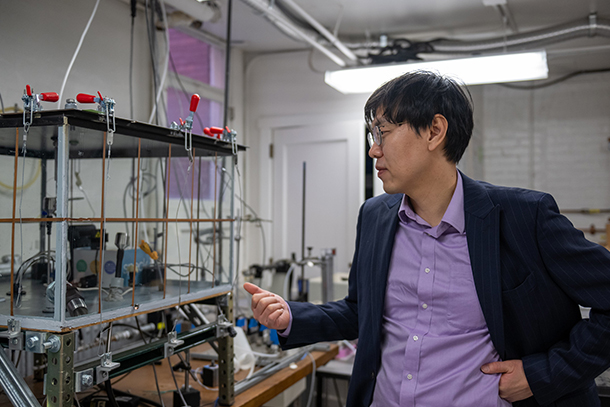
Donghyun Rim, associate professor of architectural engineering, gestures toward a test chamber to evaluate performance of low-cost air quality sensors. Rim and other researchers examined the impact of human presence on indoor air quality and discovered reactions that impact indoor air quality. Credit: Jeff Xu/Penn State. All Rights Reserved.
Humans play role in reactions that impact indoor air quality, research finds
March 3, 2023
By Sarah Small
UNIVERSITY PARK, Pa. — Humans spend about 90% of their time indoors, so understanding indoor air quality is critical for human health. But how do humans impact air quality? A team that includes Penn State researchers examined the impact of human presence on indoor air quality and found that human skin oil can react with indoor ozone to produce hydroxyl (OH) radicals, which, in turn, react with other molecules to produce sometimes hazardous byproducts.
The results were published in Science.
“Before, people would say that humans are chemically independent and not part of the indoor chemistry,” said co-corresponding author Donghyun Rim, associate professor of architectural engineering at Penn State. “But our study shows that humans are actually main contributors of the chemical processes in the indoor environment.”
According to Rim, most of the previous indoor air quality studies focused on the reactions produced by ozone interacting with building materials and surfaces rather than human-chemical reactions. He said that previously researchers were unaware that such reactions indoors were producing OH.
“People thought OH is prevalent outdoors because OH is basically produced from outdoor photochemical reactions or oxidations,” Rim said. “Whenever there's sun and some organic molecules with ozone, you have an OH radical. But what we showed in this paper is OH is coming out of the reaction between human surface — human skin oil — and ozone. And OH is important because it’s a very strong oxidant, so it’s reacting with many organic compounds and sometimes producing byproducts that can be pollutants or hazardous gases. For example, it can — but doesn’t always — produce formaldehyde, which is a carcinogen.”
Collaborators at the Max Planck Institute for Chemistry and the Technical University of Denmark used a laboratory chamber to study emissions from human skin and breath and their interactions with other constituents in indoor air, with a focus on concentrations and transport of different gases around humans depending on the building conditions. Rim and his team then used computational modeling to analyze pollutant dynamics around humans, especially the human breathing zone.
“With our modeling, we can visualize the detailed chemical processes around humans and understand better what's going on,” Rim said.
While this work demonstrated that human surfaces can interact with ozone indoors, the researchers said they plan to examine how other surrounding surface types — such as furniture materials — and personal care and cleaning products may affect the quantities of the OH radicals produced. They also plan on evaluating how those findings may differ in more energy efficient and low-carbon emission buildings.
“Passive houses and energy efficient buildings are getting more and more popular because of concerns about energy and carbon use,” Rim said. “But what are the implications of the breathing air quality that we have in those airtight, energy efficient buildings? What kind of human-chemical interactions are occurring and what byproducts are coming out of these reactions? That’s what we would like to investigate further.”
Other contributors include Youngbo Won, postdoctoral researcher in the Penn State Department of Architectural Engineering; Nora Zannon, Nijing Wang, Lisa Ernle, and Mengze Li in the atmospheric chemistry department at Max Planck Institute for Chemistry, Germany; Pascale S. J. Lakey and Manabu Shiralwa in the Department of Chemistry at the University of California, Irvine; Charles J. Weschler of the Technical University of Denmark and Rutgers University; Gabriel Beko and Pawel Wargocki of the Technical University of Denmark; and Jonathan Williams of the atmospheric chemistry department at Max Planck Institute for Chemistry and the Cyprus Institute.
The Alfred P. Sloan Foundation funded this collaborative work.



